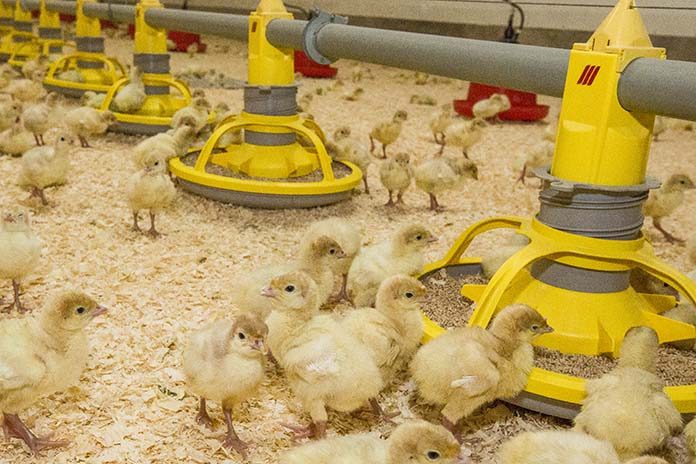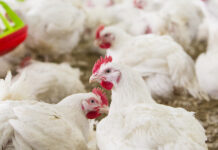
Arabinoxylans account for 50-70% of the NSP feed enzymes present in cereal grains and make up the majority of cell wall NSP in corn, wheat, rye and barley. The arabinoxylans associated to cellulose in the cell wall tend to be insoluble in water; however the soluble fraction can form highly viscous solutions in the animal gut, although this is less important in corn than in wheat and rye, where the soluble portion is larger. The most widespread NSP-degrading feed enzyme is xylanase, which is involved in arabinoxylan degradation, hydrolysing the 1,4-D-xylosidic linkage between xylose residues. In a typical UK diet, based on wheat, it is often expected that the reduction in viscosity is the main cause of benefits seen from adding a xylanase. However, in turkeys viscosity is perceived to be less of a challenge than it would be in broilers; however, the use of xylanase can benefit performance through the improvement of apparent metabolisable energy and nutrient digestibilities in turkeys as well as in broilers. More recently, the mode of action of xylanases have been related to factors not related with viscosity. Currently there is evidence that the use of xylanase in corn-based diets for poultry results in performance improvement and enhance digestibility despite the lower portion of soluble arabinoxylans, highlighting that mechanisms other than viscosity reduction are important. Possible mechanism for this have been proposed over the years, with initially a focus on the potential for the xylanase to break through cell walls and thus enable the nutrients within the cells to become available to the animal. The debate still remains on how xylanases interact with cell walls. If the effect on the cell walls is a direct effect by xylanases or an indirect effect through the higher grinding activity in the gizzard through the gut-brain axis stimulation by xylanases still needs further investigations.
Recent research has focussed on the interaction between the use of xylanase and the gut microbiota as a possible way to partly explain the positive effects seen especially in those animals fed non-viscous diets. The oligosaccharides (OS) released as a result of xylan degradation in the distal sections of the gastrointestinal tract (GIT) may be the responsible. OS seem to be involved in several functions in the intestine: promoting butyrate-producing bacteria in the intestinal tract, optimizing colon function, influencing the composition of short chain fatty acids (SCFAs), increasing mineral absorption and immune stimulation, and increasing the ileal villus length. In turn, the presence of SCFA in the lower intestine can result in feedback to increase retention time in the gizzard, which will help actually opening up cell walls. Performance improvement can thus be related to a variety of factors, all interlinked. This paper will show some of the evidence that has been produced in this area.
Production of OS by different enzyme products
The aim is to produce OS useful for bacterial fermentation. Pure xylose or arabinose production is something that should be avoided as has already been shown to be detrimental to animal performance at both swine and poultry diets. Different xylanases have different characteristics, resulting in different end-products. For example, the xylo-oligosaccharide (XOS) profile obtained after one hour incubation of wheat arabinoxylan with two sources of xylanase, a single-monocomponent xylanase (Econase XT) and an older generation enzyme product claimed to have a number of activities, resulted in very different proportions of XOS. The older generation enzymes produced more X1 (xylose) and X2 (xylobiose), whilst the single xylanase produced about 2 times as much of the 2-7 xylose unit XOS, indicating that these enzymes could produce different XOS in the gut.
Changes in the microbiome
Measuring and describing the microbiome can be done in a variety of ways: microscopy, traditional culturing methods or by molecular techniques. However, with the vast advance in molecular tools knowledge nowadays, the latter is the preferred option as they can give the most reliable results about the microbial composition of a complex sample like digesta. One feasible and extensively used method is the use of full-genome guanine+cytosine (G+C) profiling which is free of biases common to PCR- and hybridisation-based methods. It depicts the total microbial community diversity in a single profile according to their content in guanidine and cytosine. The G+C profiling has been used in various studies in poultry. The advantage of this technique is that it gives a reflection of the complete microbiome in a direct way, and correlations between performance and shifts in microbial profile have been shown in broilers. In a recent study with female turkeys, a shift was seen as a result of the use of xylanase, and this was also linked to improved performance. During a 84 day study, weight gain tended to be improved 163 g (from 7560 g in the control to 7723 g in the xylanase-treated birds; P=0.071) and FCR was significantly improved (Control 2.09, Econase XT: 2.02; P=0.007).
The analysis of SCFA may complement the microbiota profiling and help the understanding about the interactions that can take place in the gut. The reason for this is that the fermentation of carbohydrates tends to produce beneficial volatile fatty acids, such as butyric acid, whilst fermentation of protein leads to the production of branched chain fatty acids and potentially toxic amines. Characterisation of the fermentation by looking at the end products can thus give an indication of how well feed characteristics influence fermentation. It is important to note that measuring the concentration of SCFA in intestinal content is a point in time measurement and may not totally reflect their production as SCFA will be utilised by the intestinal epithelium and not necessarily accumulate in the hindgut digesta.
Similar measurements in the caeca of the turkeys from the earlier study showed no significant differences in SCFA concentration or profile, which may have been due to the limitations of the techniques used. The problem encountered is that measuring SCFA in the caeca at a single point in time may not convey any information on the rate of production, degradation and absorption (i.e. the flux) of these SCFA or the frequency of caecal evacuation. Given the change in microbial profile, it is likely that a change in fermentation pattern did occur which may have been the reason for the improved performance observed.
Conclusions
Supplementation of turkey diets with xylanase can improve performance through various mechanisms. The shifts in the microbial profiling as a result of feeding xylanase may be due to the provision of oligosaccharides, stimulating the development of a fibrolytic fermentation in the hindgut. This positive change in the microbiome is proposed as a novel way to consider how xylanases works. The benefit of looking at it this way is that it explains why xylanase can work in animals where viscosity is less of an issue and also why the responses may increase with animal age. Similarly, it gives an explanation for the efficacy of enzymes in corn-soy diets.
References are available on request
















